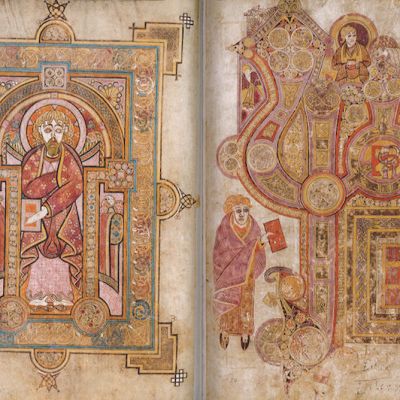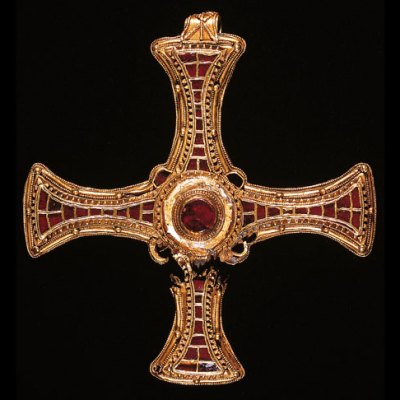From the September 2018 issue of Apollo. Preview and subscribe here.
On 12 March 1455 Enea Silvio Piccolomini (later Pope Pius II) wrote to Cardinal Juan de Carvajal. His tone was breathless: ‘It seems what I had been told was true,’ he wrote, ‘I have not seen entire Bibles, but I have seen signatures of five folded sheets.’ It is hard to imagine today how radical those folded bits of paper must have seemed. Piccolomini was, of course, discussing the work of the ‘vir mirabilis’ [admirable man], Johannes Gensfleisch zur Laden zum Gutenberg, and his printed Bible, produced using moveable metal type, which was to become a landmark of European culture.
 Taschen’s new facsimile of the copy of the Gutenberg Bible now held in the Niedersächsische Staats- und Universitätsbibliothek in Göttingen is a weighty thing, with as much scholarly as physical heft. It is a little unusual to produce a facsimile of a printed book, but the B42 (as the Bible is known in scholarly circles for the number of lines it has on each page) is quite like a manuscript in many ways. For one thing, it is printed on vellum, the traditional material on which manuscripts were written until paper became more common in Europe from around the 14th century. Also like a manuscript, the borders of its pages have been hand-decorated, as per the owner’s request – Gutenberg’s bibles were sold unbound and undecorated allowing owners to customise them. (Some 49 Gutenberg Bibles survive, but each is quite different.) And important headings in red ink (known as rubrication) have been added by hand. Gutenberg initially printed the headings in red ink before deciding that it would be cheaper to pay a professional scribe to fill them in, rather than go to the trouble of re-inking.
Taschen’s new facsimile of the copy of the Gutenberg Bible now held in the Niedersächsische Staats- und Universitätsbibliothek in Göttingen is a weighty thing, with as much scholarly as physical heft. It is a little unusual to produce a facsimile of a printed book, but the B42 (as the Bible is known in scholarly circles for the number of lines it has on each page) is quite like a manuscript in many ways. For one thing, it is printed on vellum, the traditional material on which manuscripts were written until paper became more common in Europe from around the 14th century. Also like a manuscript, the borders of its pages have been hand-decorated, as per the owner’s request – Gutenberg’s bibles were sold unbound and undecorated allowing owners to customise them. (Some 49 Gutenberg Bibles survive, but each is quite different.) And important headings in red ink (known as rubrication) have been added by hand. Gutenberg initially printed the headings in red ink before deciding that it would be cheaper to pay a professional scribe to fill them in, rather than go to the trouble of re-inking.
The B42 was, of course, a great innovation which would irreversibly change the course of European history, enabling the mass production of texts as never before: 180 were printed in two years. During that time a single scribe would have barely dented the work of copying a manuscript Bible. Yet, despite this mechanised production, each copy was bespoke. The marriage of new technology with individualised design made the B42 a sought-after object; when Piccolomini wrote to Cardinal Carvajal there was already a long waiting list for one of the Bibles and, in time, the technology would come to be available to ordinary people.
The facsimile is large – the size of the original – and comes in a sturdy cardboard box with a plastic handle at the top; you would not want to carry it any distance. The intention has clearly been to give readers a sense of the feel and weight of the original two-volume, vellum codex. The facsimile also conveys something of the physicality of the Bible’s pages: the notes and corrections left by readers and the variable appearance of its vellum. You can see the ghost of the skin’s former hair follicles; small, faint stains, and even the occasional hole.
Page from the Gutenberg Bible (vol. 1, fol. 5r), 1454, printed by Johannes Gutenberg. Niedersächsische Staats- und Universitätsbibliothek, Göttingen. Image courtesy Taschen; © TASCHEN/Göttingen, Niedersächsische Staats- und Universitätsbibliothek

Despite the chance smudges to the printer’s ink, the overall impression is of the Bible’s crisp, clear type and its impeccably justified columns of text. Piccolomini praised Gutenberg’s printed pages as being so clear they could be read ‘without spectacles’. In order to achieve this, Gutenberg used 290 letter forms, including ligatures and punctuation marks, to give elegant and even spacing between letters and words. That said, there are instances where the rubricator – the scribe employed to add red ink headings – almost seems to taunt the printed letters by adding hair-line strokes to his own letters, of a kind that only a scribe would be able to produce. That you can see this contrast in the facsimile is a testament to the quality of what Taschen has produced.
Alongside the two-volume facsimile, the edition also comes with a scholarly commentary and appendices produced by Stephan Füssel. This volume is mercifully lighter than the two it comments on – my copy came on an Italian holiday with me – and contains facsimiles, transcriptions and translations of the Göttingen Model Book and the Helmasperger Notarial Instrument. These two manuscripts are key to understanding Gutenberg’s life and working practices. Many aspects of the printer’s life are hazy: there are no contemporary images of him and we do not even know the exact dates of his birth and death.
The Göttingen Model Book is a vellum manuscript produced around 1440–60 and is a kind of design manual containing instructions on how to produce decorative initials and foliage designs. The Model Book’s importance lies in the fact that not only do we find these very initials and designs in the Göttingen copy of the Gutenberg Bible, but chemical analysis also reveals that the inks in the Bible and the Model Book share the same chemical composition, strongly suggesting that the decoration was produced in the same workshop.
Page from the Gutenberg Bible (vol. 1, fol. 63v), 1454, printed by Johannes Gutenberg. Niedersächsische Staats- und Universitätsbibliothek, Göttingen. Image courtesy Taschen; © TASCHEN/Göttingen, Niedersächsische Staats- und Universitätsbibliothek

The Helmasperger Notarial Instrument is written in the hand of Ulrich Helmasperger, a notary in Mainz in 1455. It details a legal dispute between Gutenberg and his financial backer, Johann Fust: Fust dissolved the business partnership after the printing of the B42 and the liquidation led to a quarrel between the two. Looking at the pages of the B42 facsimile, or indeed the Model Book, it would be easy to think of Gutenberg as an artist and designer, but the Instrument reminds us that he was also a businessman.
Gutenberg’s project was, as Füssel notes, ‘the outcome of years of experimentation and creative fine-tuning’, but it was also a commercial venture and one that was enabled by a larger social context: ‘Gutenberg’s circle included financiers, advisers, theologians, paper mill owners, carpenters, goldsmiths and other craftsmen.’ We have a sense of Gutenberg as the 15th century’s equivalent of a Silicon Valley tech entrepreneur. It is interesting to speculate about which of today’s inventors and inventions will still be lauded in six centuries’ time.
The Gutenberg Bible of 1454 by Stephan Füssel is published by Taschen.
From the September 2018 issue of Apollo. Preview and subscribe here.



